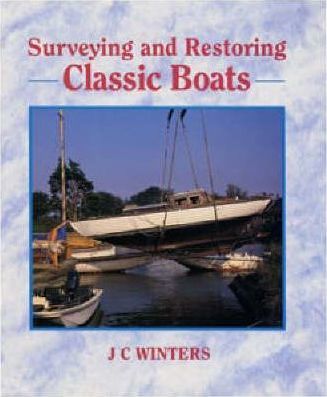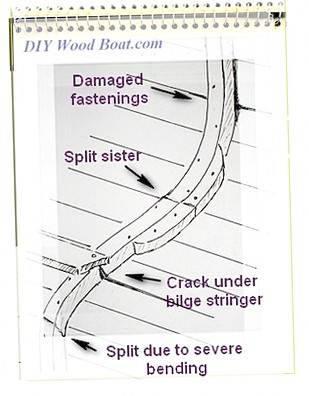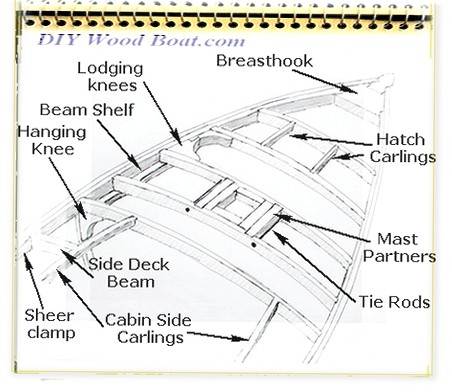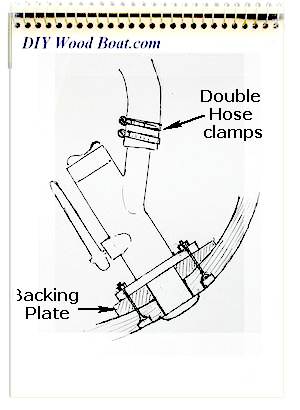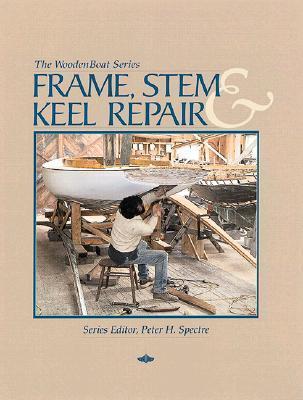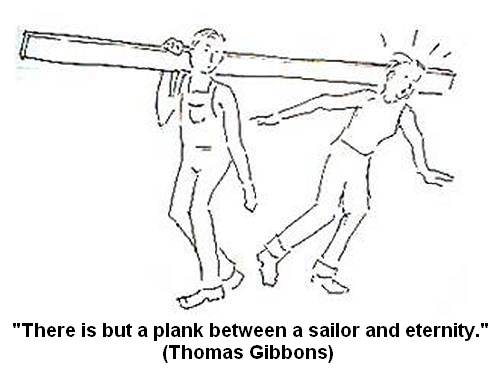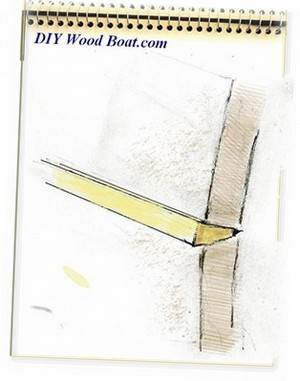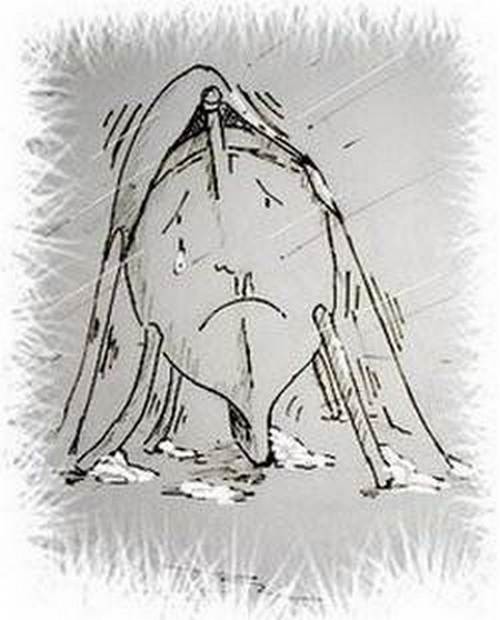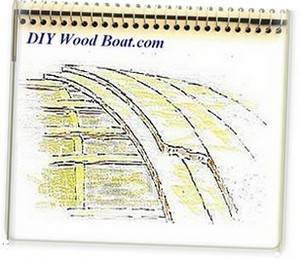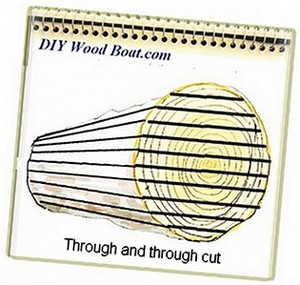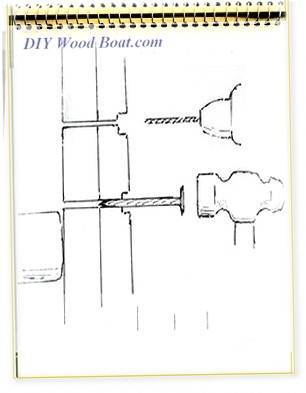- Home
- Your Boats
- Surveying
Wooden Boat Surveying
When surveying a wooden boat be aware that a wooden hull is a complex structure.
Weakness in one area will have an effect on others.
When you are checking specific areas try to keep the overall picture in
mind.
Start by standing back, look at her from directly in front or astern,
make sure
she is symmetrical around the centreline.
Look from abeam to see that she doesn’t droop at the ends.
Every boat is different, so it’s impossible to give a definitive method
for checking.
Let’s start by considering the materials.
Then have a look at some specific component parts.
Wood
Before a tree is cut down it naturally
conducts water soluble nutrients
up along the grain.
Normally the wood does not readily absorb moisture across the
grain.
Once chopped down and cut into planks it looses much of this
ability.
So it will only absorb moisture for a short distance along from the
end, until rot sets
in and then the moisture will advance further
causing more rot, ad-infinitum.
Rot
is generally
caused by fungicidal
micro-organisms which need moisture to survive.
However
where the timber has suffered from ‘wind
shakes’ minute
splits in the fibers will make the wood more porous across the
grain.
As a result a plank can for no apparent reason rot from the
middle.
The wood of a boat is constantly being soaking in water, some areas
being alternately soaked and dried.
It is also being subjected to damage from micro-organisms, shipworms,
ants, termites as well as the normal stresses imposed on the
hull.
On top of that, all sorts of chemicals are allowed on to it, such as
spilled battery acid, diesel, detergents, and the like.
Yet despite all this there are still many old boats still afloat after many, many years.
I wonder how many plastics boats will survive for as long.
Fasteners
While most of a wooden boat is made up of timber, it is all held together with metal fasteners.
And metals are unfortunately all subject to corrosion.
Now, contrary to popular belief galvanism is rarely, really a problem with wooden boats.
The primary cause of most corrosion to hull fasteners is oxygen starvation, sometimes known as crevice corrosion.
This is caused by water being trapped in a small, confined space where there is little oxygen.
It occurs mostly, where metal fasteners join two pieces of wood together.
This wastage or necking as it’s sometimes called, usually begins at the center of the fastener at the interface between the two pieces of wood.
This is where water will be drawn into the seam by capillary action.
Once the fastener has been wetted a few times, it begins to oxidize.
Once the oxidization process starts the capillary effect attracts more moisture accelerating the effect.
At the same time because of the lack of oxygen in the cavity a chemical reaction turns the water acidic, which naturally makes things much worse.
It is this acid corrosion which shows up as pink and black on bronze fasteners and as a very black coating on iron and steel.
The only thorough way to check fasteners for integrity when surveying is to draw them out and inspect them.
Now this might be reasonably simple to do with screws, but where a boat has been nailed or riveted it becomes almost impossible without causing damage to the planks and frames.
The safest bet is to be cautious, regardless of the age of the boat or the fastening material.
However be doubly suspicious of any form of steel fastenings.
And when in doubt be prepared to replace them.
affiliate linksKeel
Wherever you start your inspection the main areas to check are the major structural members.
And you can tell almost as much from surveying inside as you can from the outside.
Check the keelson, the floors, clamps stringers for any signs of working, such as uneven scarph joints or any rubbing or chaffing that might indicate movement.
Use your screwdriver to probe the keelson for any signs of softness.
Check visible bolts and bolt heads for any signs of corrosion or discoloration around the heads.
If the wood around the bolt heads is soft this will probably be a sign that water is getting at them causing serious corrosion.
If your boat has an external ballast keel and if there is any doubt about the Keel Bolts they must be drawn and checked thoroughly.
Check the transverse frames and floors for signs of rubbing or chaffing or softness.
Look at the mast base of a keel stepped mast for movement and softness.
Surveying Frames
While you are still surveying inside with that screwdriver in you hands, gently pry under any frames especially where they are through bolted to the floors.
Any gap between planks and frames or movement is a sign of fastener problems.
Test the wood for softness in the planks and frames near their mating surfaces, especially near the keel and along the garboards.
If the frame is cracked, the ends split or the wood is soft, they will need to be replaced or at the least ‘sistered’.
Have a special look at the frame in behind the bilge stringers for any cracks.
Surveying Planks
As well as checking planks visibly, tap then with the handle of your screwdriver or a wooden mallet, listen for any dull sounds.
Sound planks should ring, a dull thud most likely means rot or at best loose fasteners.
If you still haven’t bought this boat be careful not to cause any damage even if the plank is rotten, the owner may not be amused.
Look for discoloration around the heads of any fasteners, water stains and evidence of corrosion such as rust or green copper oxides.
On the inside, the accumulations of dried salts will also be evidence of weeping.
The two most common areas for sprung planks to occur are in the garboard and the forefoot areas.
Pay special attention to plank ends, especially butt and nib ends and the fasteners there.
‘Angle hair’ or shredded wood fibers, is caused by constant wetting with sea water and then drying. Salt crystals accumulating in the wood damage the wood cells.
However, if the damage is only on the surface this can easily be cleaned off.
Check seams for damaged caulking.
It is not uncommon for seams to show signs of cracking when a boat has dried out.
Providing the caulking compound has not become hard and brittle these should close up again when the boat is launched and the wood takes up.
Where the compound has become brittle it will be worth your while doing a complete re-caulk.
Chine Areas
Chines are areas of high stress, which are prone to leakage. Any leakage will endanger the fasteners.
Where the transom intersects with the bottom and side planking is another area where leakage and deterioration are likely to occur.
Check for any open seams and signs of rot on the corners.
When surveying, pay particular
attention to any seams
that could allow rain water in, as fresh water can be disastrous for
wood.
Bulkheads
Bulkheads are structural elements, they are not simply there to separate areas of accommodation.
Any loose, rotting or other wise damaged bulkheads must be replaced.
BooksSurveying Decks
Walk around on deck, feel for soft or springy areas.
Pay particular attention when surveying, to the areas around fittings such as stanchions, any looseness will have allowed water to penetrate.
Look inside for signs of leaks on the deck head and under the side decks.
Tapping with that screwdriver or mallet will sow up any bad spots, you will hear the difference.
A properly laid planked deck relies on caulked seams, any leaks here may result in water penetrating the substrate and the deck beams.
Check below for any signs of weeping and rot.
Where a deck has been covered, be it painted cloth or plywood panels, pay particular attention to the edges.
Many so called teak deck are veneered panels of plywood, look out for delamination as well as seepage under the panels.
If she has a keel stepped mast, examine where it goes through the deck (the partners).
Check that the mast boot is sealing properly.
affiliate linksSurveying Sea-cocks
Through Hull Fittings and sea cocks, being metal are subject to the usual water stains and corrosion such as rust or green copper oxides, accumulations of dried salts and the like.
If they have ceased up then they need to be replaced or removed completely.
The fasteners holding the sea cocks and the sealant between the metal and wood must be checked and preferably re-seated.
And while we are on the subject of metal bits check the pintles, gudgeons and other bits associated with the rudder.
Any worn bushings will feel loose, there should be no play at all in either a wheel or a tiller.
